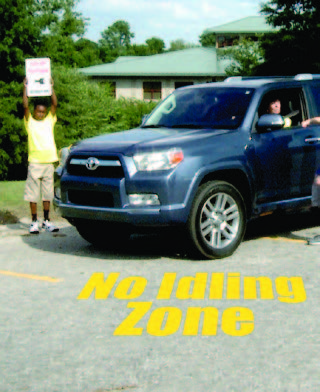When a vehicle is running but not moving (or not stopped in traffic), it is idling. Examples include trucks waiting in line at a weigh station, delivery trucks waiting to unload goods, taxis waiting for passengers, or a parent idling their car while waiting for a child at school. For many reasons, this is not a good practice. Pollution from vehicle exhaust has been linked to asthma and other respiratory diseases, and it increases the risk of long-term health effects. Idling reduction policies, “no idling” regulations, and anti-idling campaigns, have been, and can be, adopted by many types of organizations, companies, and governments.
Why is this important to your community?
According to the U.S. Department of Energy Alternative Fuels Data Center, about 6 billion gallons of fuel is wasted in the U.S. each year due to vehicle idling. This equates to money, because idling wastes between 0.4 to 0.6 gallons of fuel per hour, while releasing many pollutants into the air and increasing vehicle maintenance costs. Pollution from motor vehicles contributes to the formation of ground-level ozone, which has been proven detrimental for cardiac and respiratory health, particularly for children and the elderly. Asthma affects approximately 90,000 children in South Carolina and an estimated 322,007 children in North Carolina (2007); this chronic condition is a major cause of school absences and hospitalizations Currently, the entire CONNECT region is not meeting federal standards for ground-level ozone, which in itself represents additional compliance costs. Vehicle idling generates air pollution that impacts public health, is bad for the environment and incurs additional costs for taxpayers and the private sector.
Skip directly to
How Does It Work?
Resources
Using the Tool
Partners
Where Has It Worked?
Where is it appropriate to use?
What priorities does it address?
What other tools are related?
How does it work?
Despite many anti-idling policies and regulations in place, idling is still common across vehicle types. Personal vehicles are often idled while waiting to pick up friends and family from their homes or the store. Buses are often idled picking up children from school or riders from the bus station. Both North Carolina and South Carolina have existing restrictions limiting idling for on-road heavy duty vehicles, including school buses. Communities can expand on the state regulations by adopting local policies or regulations to reduce idling and can educate the public about negative impacts. Through signage, educational materials, and idle-free campaigns, such as setting up idle-free zones around schools or day cares, communities, schools, and businesses can collectively reduce vehicle idling, improve air quality and public health, and save money.
Ready to get started?
Using the Tool
- Review idle reduction information. There are many anti-idling resources and educational materials available to assist communities and organizations. The IdleBox Toolkit under resources is a good place to start.
- Engage in education: Meet with local officials and owners or operators of common idling locations (e.g., schools, bus stations, shopping centers, drive-through establishments), educate business owners and vehicle operators of the impacts of idling, etc.
- Assess different strategies for reducing idling. For example:
- Voluntary site-specific anti-idling zones (e.g., commercial districts, schools, public buildings)
- Community-wide idling reduction policies or ordinances (could apply only to city vehicles or include private vehicles)
- Installing idle mitigation systems (allowing heating, cooling, and power while the engine is turned off)
- Advocate for greater state-wide idling reduction legislation (existing legislation is limited to vehicles over 10,000 lbs, and school buses in NC)
- Provide assistance in the implementation of the preferred idling reduction strategy. This could include developing additional or customized educational materials, model ordinances or legislation, and/or signage.
- Model idle reduction—it’s hard to get others to do what you don’t do yourself. Check in and monitor compliance with your organization’s fleet. Conduct a survey or speak with managers as need to understand barriers to implementing the policy if needed.
Partners
- Advocacy Groups
- Airports
- Colleges and Universities
- Departments of Education / School Districts
- Elected Officials
- Municipal Departments
Where has it worked?
No-Idling Policy - Concord, NC
About the Program
The City of Concord has a no-idling policy that applies to the city’s fleet of over 1,000 vehicles and equipment. In addition, Concord is working toward fleet diversification by replacing older vehicles more fuel-efficient and cleaner operating vehicles and equipment to reduce fuel usage and improve air quality.
Why it works
The City of Concord’s Fleet Services Department was recognized in 2011 as the 48th best public sector fleet operation in North America. The city’s no-idling policy is one of many efforts it has taken to improve the environment and reduce emissions—leading to reduced costs and earning the city national recognition. In a 2010 survey of seventeen participating municipalities, Concord had the lowest costs per vehicle.
http://www.concordnc.gov/Home/ArticleType/ArticleView/ArticleID/416/PageID/416
Winthrop University No Idling Policy - Rock Hill, SC
About the Program
Established in 1992 and working as an all-volunteer group for most of its 20-year history, the Katawba Valley Land Trust is a non-profit conservation organization dedicated to the protection of natural and cultural resources in the Catawba River Valley of South Carolina. KVLT works with landowners who wish to preserve their land through conservation easements, donation, or sale. The organization is supported financially by individual membership dues, support from our corporate partners, and grants.
KVLT emphasizes environmental education and outreach efforts by publishing books such as Spider Lilies: The Rocky Shoals Spider Lilies of Landsford Canal State Park, distributing stunning photographs and post cards of significant natural resources, conducting research on wildlife species, holding public lectures, coordinating environmental education efforts in the local schools, conducting an annual speaker series and leading hikes and bird counts and other events promoting love and stewardship of the natural environment.
Why it works
KVLT has protected over 8500 acres of land in five South Carolina counties through conservation easements, acquisition, or transfer to other management agencies. Areas of focus for KVLT’s conservation efforts have included buffers along the Catawba River and its tributaries, the Landsford Canal and Forty Acre Rock areas, the Great Falls area and the Lancaster Greenway Preserve.
KVLT uses national standards to monitor and manage its holdings and established a stewardship endowment to ensure perpetual care. Many of the land trust’s conservation efforts involve partnerships with local, state, or federal agencies and other non-government organizations to accomplish conservation objectives. Some of KVLT’s partnership-driven successes include:
- Expansion of the protected area around Landsford Canal State Park in Chester and Lancaster counties from 200 acres to over 1,400 acres
- Creation of the Lancaster Greenway Preserve, a necklace of green that provides urban open space of over 350 acres along the major creeks through the City of Lancaster
- Purchase of the Heritage Tract, protecting over 2,000 acres surrounding the reservoirs at Great Falls in Chester County
- Protection of a working family farm in Chester and York counties through an innovative purchase development rights initiative, through funding from the South Carolina Conservation Bank
- Initiation of the Catawba Master Naturalist Program, providing intensive training for citizen scientists in cooperation with Clemson University, USC-Lancaster, and other local entities
Department of Health and Environmental Control (DHEC) Breathe Better - South Carolina
 Image Source: South Carolina Department of Health and Environmental Control.
Image Source: South Carolina Department of Health and Environmental Control.
Contact
DHEC Bureau of Air Quality
Debra Briggs-Monroe
803-898-3752
briggsmd@dhec.sc.govLeslie Coolidge
803-898-3208
coolidln@dhec.sc.govAbout the Program
Breathe Better is an anti-idling/clean air campaign. The goal is to protect the health of children by reducing harmful vehicle emissions around school campuses. Students are taking actions, such as educating drivers about idling, posting “no idling” signs around the school campus, and implementing other school projects aimed at improving air quality, such as planting trees and encouraging alternative modes of transportation. The Breathe Better campaign is a voluntary initiative. It is an environmentally sustainable project that can be easily developed, implemented and maintained. There is zero cost to your school or organization to participate.
Why it works
Since the inception of the Breathe Better program, a number of schools in South Carolina have adopted and successfully implemented no-idling programs and achieved measurable goals. For example, Dover Elementary School (North, SC) has created a healthier environment for students, faculty, staff and community. The program at Dover ES:
- Saved fuel and eliminated emissions for approximately 9,000 cars and 1,250 school buses;
- Committed to practicing anti-idling on and off campus;
- Reduced the waiting period for the preschool and kindergarten carpoolers down to 5-7 minutes;
- Planned for future discussions to include expanding the Breathe Better program throughout the school district.
- Airports




